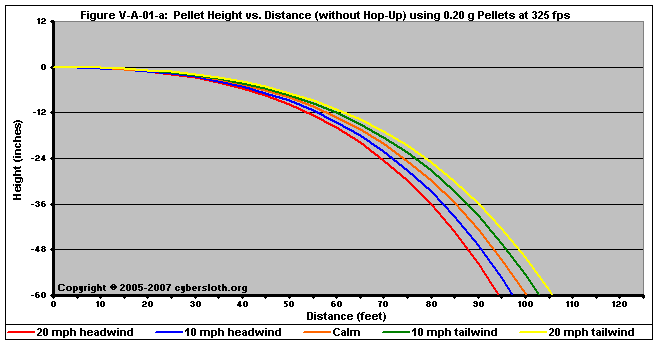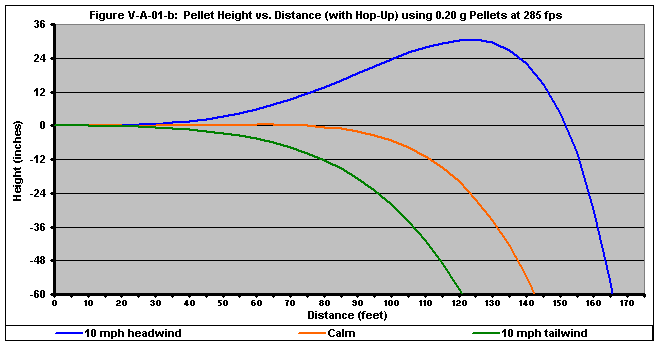Section V-A-01: Headwind/Tailwind Component
When firing into a headwind (wind flowing from target to shooter) or tailwind (wind flowing from shooter to target), it is perfectly sensible to expect the wind to affect the trajectory of the BB. Figure V-A-01-a shows the modeled trajectories of a 0.20g BB fired at 325 fps into varying wind conditions. As expected, a non-spinning shot fired into a headwind would experience additional drag, consequently retarding its forward motion. Conversely, a tailwind will prolong the BB's trajectory as the BB will experience less drag over the course of its trajectory.

While the trajectory of a BB without hop-up seems intuitive, trajectory of a BB with hop-up applied seems to defy our expectations. Figure V-A-01-b shows the trajectories of BB's with hop-up applied for a 0.85 J rifle fired into the wind:

Common sense tells us that a headwind should produce lesser trajectories. Unfortunately, this isn't what the model predicted. Initially, there was worry that there was something wrong with the model and testing was in order. Using a 1.5 J rifle (400 fps w/ 0.20g BB's), we set out to see how headwinds and tailwinds affected trajectory. First, the direction of the wind was determined and two targets were set up on a flat field, 150' apart with the two targets aligned with the direction of wind. The next step of the test was to take the rifle to the downwind target and fire shots at the upwind target (i.e., into the wind). Then, shots were fired from the upwind target to the downwind target. Strangely, observation matched the model results -- shots fired into the wind went further than the shots fired with the wind at our backs.
Some quick data mining helped to explain why spinning shots gained distance when fired into a headwind. As was explained in detail in Section III: Effects of Hop-Up, the amount of lift generated by a spinning BB is directly dependent upon the ratio of rotational velocity (V) to the linear velocity (U). High V/U causes significant lift; low V/U does not. When firing into a headwind, the linear velocity U decreases at a much faster rate than normal, while the rotational velocity V decreases at the same rate regardless of whether it is calm, a headwind or tailwind. For a headwind, V stays the same but U is lower, meaning that the ratio of V/U is ultimately higher, leading to greater lift. Essentially, shots fired into the wind tend to "over hop" leading to greater trajectory.
Another, perhaps simpler way to look at it is to realize that trajectories for normal projectiles are greatly limited by air resistance. A headwind will provide greater air resistance for normal projectiles, limiting their trajectory. Spinning BB's are primarily limited by the effects of lift. A headwind will ultimately lead to greater lift at range, thereby increasing the trajectory of spinning BB's.